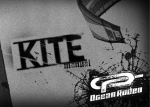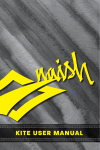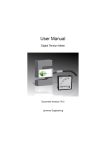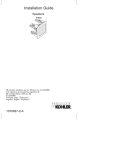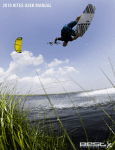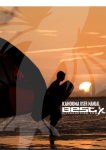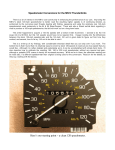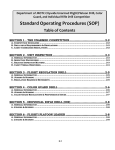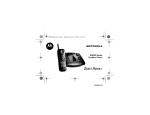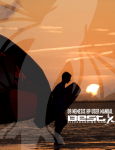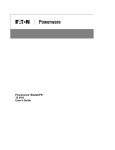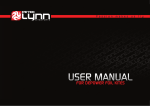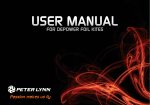Download ONE Kite - Ocean Rodeo
Transcript
Notes _________________________________________________ _________________________________________________ _________________________________________________ _________________________________________________ _________________________________________________ _________________________________________________ _________________________________________________ _________________________________________________ _________________________________________________ _________________________________________________ _________________________________________________ Take a lesson! Before you launch any kite, it is imperative to take certified kiteboarding lessons. For Information on lessons in your area go to www.oceanrodeo.com. Table of contents Important Notice________________________________4 Kite care and maintenance______________________20 Introduction_ ___________________________________4 Strut bladder removal___________________________20 Caution_________________________________________5 Repairing the bladder___________________________22 Selecting Kite size_______________________________6 Strut bladder replacement______________________22 Location________________________________________6 Leading edge bladder removal___________________24 Assembly of kite_________________________________7 Leading edge bladder replacement_______________24 Punch-UP Kite bar______________________________10 Warranty______________________________________26 Attaching flying lines to your OR flat kite__________12 Launching Your Flat Kite_ _______________________15 Important Notice This is not a kiteboarding instruction manual! Reading this manual does not eliminate the need for professional instruction in the sport of traction kiting. The user is therefore advised to obtain such instruction in addition to familiarizing himself or herself with the information contained in this manual prior to flying this or any other power traction kite. Competent instruction may be obtained through an authorized Ocean Rodeo dealer or local professionally qualified kiteboarding school. For information on lessons in your area go to www.oceanrodeo.com. Introduction Congratulations on purchasing an Ocean Rodeo kite. We trust that you will find it to be a superior product. Our kites are the result of years of passionate R&D mixed with technical expertise. Enjoy! A label showing your serial number is sewn at the underside of the leading edge center strut. 4 Important For simplified warranty claims and product updates please register your product with Ocean Rodeo (via our website www.oceanrodeo.com or mail in coupon found on the back page of this manual). A user manual and release of liability agreement is included with each new kite. Read it. (Release of liability is printed at inflation point on leading edge tube.) Replacement manuals may be obtained from the ocean rodeo website: www. oceanrodeo.com. If additional outfitting is required use manufacturer’s approved materials only. Do not impair or remove any safety release systems. The user of this product acknowledges both an understanding and an assumption of the risk involved in kite powered sports. Caution Safety Warning Kite powered sports can be very dangerous and physically demanding. The user of this product should understand that participating in kite powered sports may involve serious injury or death and agrees to observe the following safety precautions: • Get instruction specific to the type of kite power craft. • Obtain first aid training and carry first aid and safety/rescue devices. • Consult your physician prior to beginning kite powered sports training. • Always wear a nationally approved personal floatation device when using a kite on water. • Always wear a helmet. • Dress appropriately for weather conditions; cold water and/or cold weather can result in hypothermia. • Check your equipment prior to each use for signs of wear or failure. • Never kite alone. • Do not kite in overpowered, gusty wind conditions. • Do not kite in offshore wind conditions. • Before launching from an unfamiliar site be aware of any dangers (rocks, reefs, currents, changeable weather, etc). • Scout unfamiliar sites before launching. • Never launch from an area with any obstacles closer than 2 line lengths downwind (people, rocks, etc). • Do not kite near power lines! • Do not ask a non-kiter to assist in the launching or landing of a kite. • Always use the kite with a functioning safety system. • Always prevent kites from inadvertently launching on land by weighting with sand, gravel, etc. • Always announce when you are going to launch your kite so people can be prepared to move in the event of a gust or a problem. • Disable an unattended kite by: removing the lines; placing the kite leading edge down, facing the wind; and weighting with sand, gravel, etc. • Do not exceed your kiting ability. Be honest with yourself. • You must not use alcohol or mind altering drugs prior to using this product. 5 Selecting kite size� Location: Select the right size kite for the conditions, your ability and weight. This chart is a rough guideline. Many factors can affect your decision of which size of kite to use: body weight; wind direction and steadiness; kiting ability; line length, etc should all be considered. When in doubt ask someone who is capable or, if there is no one to ask, err on the side of caution with a smaller sized kite! Body Weight in Lbs Body Weight in Kilos Safe site criteria The site for your kiteboarding must meet the following criteria to ensure your safety and that of others: •No power lines within 3 line lengths (100 meters) of beach •No trees 1 line length (30 meters) from beach •Free from beach obstructions: logs, boulders, slippery seaweed, etc 16M FLAT KITE 12M FLAT KITE 9M FLAT KITE 7M FLAT KITE Wind in MPH Wind in MPH Wind in MPH Wind in MPH 110 - 150 lbs 50 - 68 kg 9 - 18 12 - 22 15 - 25 18 - 30 150 - 200 lbs 68 - 90 kg 10 - 20 14 - 27 17 - 30+ 20 - 30+ 200 + lbs 90 kg + 11 - 24 16 - 30 22 - 30+ 25 - 30+ Warning: This is just a basic guide. Wind range can vary greatly depending on abilty, board size and wind quality. 6 Ideal site conditions •Side shore wind •Smooth, steady moderate strength wind (8-15 knots) •Wide sandy beach •Shallow water close to shore •Large area of beach downwind free from obstructions •A clear bottom free of rocks, corals, excessive seaweeds, etc Organize a kitesurfing area •A take off area •A water entry area •A landing area punctures. •������������������������������������������������������ Always use the largest nozzle size possible. The back draft valve can be damaged if the nozzle is inserted too far. •When pumping up a kite for its first time, make sure the inner bladder is filling up all corners of the strut. If not, see strut bladder replacement section. 2. Select an area free of obstruction, the same or larger than the span of your kite. Avoid areas with sharp objects (thorns, sharp stick, etc). 3. Starting on one wing tip weigh tip with sand and unroll kite downwind. Inflate ribs starting from upwind end and work your way downwind. [1] Assembly of kite 1. Inflation: Before you inflate your kite make sure you have a suitable “anchor” to weigh down your kite (sand, fine gravel, weight bag, etc). Important •������������������������������������������������ Before inserting pump nipple into bladder, make several pumps to clear nipple of any debris (sand, stones, etc) Debris in the bladder can cause small 1 7 Inflate the ribs until they assume their shape and are firm. Note •��������������������������������������������������������� The valves have a back draft flap, it is not required to pinch the valves to retain air pressure. •����������������������������������������������������� Make sure plug is secure in valve and held snug with Velcro closure. �[2] 3a 3b 4. While holding the leading edge remove weight from wingtip. Work your way to the center of the leading edge tube. Clip pump onto pump leash��[3a] [3b] Note •������������������������������������������������� Ocean Rodeo kites come with a dual valve system: one to inflate and one to deflate. �[4] 2 •����������������������������������������������������� Under inflation of your struts and leading edge tube will adversely effect the performance of your kite. Pump until tubes are firm! 4 8 5. Holding kite at center of leading edge rotate so that kite sits leading edge down and into the wind. Use a weight (sand, fine gravel, no sharp objects) to weigh down the leading edge of the kite. �[7]� Helpful Tip •�������������������������������������������������� We recommend using a bag that contains sand, fine gravel, etc for weighting the kite. This reduces your kite’s exposure to abrasion. 5 •�������������������������������������������������� Insert pump into valve labeled inflate and ensure exhaust valve is closed. [�5] •��������������������������������������������������� Inflate leading edge until kite assumes full arced shape. �[5] 6a 6b 7 •������������������������������������������������������� When deflating kite use pokers. Gently push into strut valves to release air. [�6a] [6b] •Do not store kite with deflate pokers inserted in valves. This can damage the back draft valve. 9 Punch-UP Kite bar. Ocean Rodeo “Flat” kites should be used with the Punch UP kite bar. We recommend you read and become familiar with the contents of the Punch UP bar manual in addition to this manual. Line Lengths And Tuning All lines must be of equal length when measured from bar to end of lines with the center line un-cleated and fully extended. With all lines equal the kite will perform well and look like the kite pictured. Note Wingtips are parallel. The increased de-power of the flat kite design can only be realized when used with a bar that offers excessive sheeting control as offered by the Punch UP Bar. For up-to-date information on this bar please visit: www.OceanRodeo.com/ PunchUpBar.html If the rear lines are shorter than the front lines the kite will be prone to stalling! It would look like the kite pictured. Note Wingtips angle inwards towards rear of kite. Wingtips Parallel Wingtips Angled inwards 10 Line length can affect turning and power of kite. Optimum line lengths are 15m to 35m. Shorter lines increase kite turn response but reduce the power window of the kite. Conversely, longer lines decrease turn response but increase the power window of the kite. Note The bridles and longer leader lines on flat style kites will make your total line length longer. E.g., Combined 3m bridle and leader line length plus 24 m lines = 27m Line Managment Kite line management is a very personal thing. Stored incorrectly they can cause hours of frustration in tangles. Attached to the kite incorrectly they can create a dangerous situation for you and others. Develop a line storage strategy that works for you and do it the same way every time! Here’s what works for us: •Don’t be a kook! Have your kite pumped up and your drysuit on (if required) before laying out your lines! Be considerate of others and recognize that tangles and confusion can result from lines left unattended! •����������������������������������������������������� Place the loose end of your lines near the center of the leading edge tube •��������������������������������� Unwind your lines walking upwind •���������������������������������������������������� Identify lines at bar end and work your way down to the kite separating the lines •�������������������������������������������������� Before attaching any lines to the kite physically separate the left front and rear, right front and rear. •�������������������������������������������������������� Lift your kite over the separated lines, leaving enough line length behind the kite so you do not have to drag the bar to make contact with the pigtails on the kite. [8] •������������������������������������������������� When storing lines re-wind in a figure 8 pattern around the bar ends to avoid twisting the line set. 8 11 Helpful Tips •����������������������������������������������������� Stand between the front lines and separate the front and back lines between your fingers •�������������������������������������������������������� Carefully work your way towards kite. If your lines are severely twisted, work in short segments starting near the loose end working away from the bar. •������������������������������������������������������� Unwinding lines directly into the wind stops the lines from twisting together. •����������������������������������������������������� Always remove seaweed from lines as it dries and can cause tangles. •Be sure there are no knots in your flying lines as they create a weak point! Attaching flying lines to your OR flat kite. 1.Before you attach your lines have your kite pumped up leading edge down and weighted with sand or gravel. 2.Your flat kite has two front line attachments and two back line attachments supported by line bridles, locate these line attachment points 12 9 •����������������������������������������������������� Front line attachment pigtails are located about 1/4 of the way up from the wing tip on the leading edge tube �[9]�� •������������������������������������������������ Rear line attachment lark’s head connectors are located at the very tip of the leading edge tube �[10] 10 Note Make sure the bridles are free and clear with no twists and any pulleys are free and clear of debris. [11] C D 4.Your front line attachment has multiple knots on the pigtail. We recommend the 3rd knot up from the end, E PULLEY towards the kite, as a good all around setting. �[12]� F However, micro adjustments can be made on the front lines to offer more de-power / power depending on G wind conditions I H •������������������������������������������������� Attaching to the 2nd knot up from the end offers FRONT ATTACH maximum power (longer front lines) REAR ATTACH 3.With the front and back attachment points free from •����������������������������������������������� Attaching to the 4th knot up offers maximum detheir Velcro storage tabs pull the pigtails / lark’s head power (shorter front lines) connectors forward so that the bridles are in clear view. A 11 B 12 13 13 15 5.The rear lines connect to the kite with a foolproof connector that prevents the front and back lines from being incorrectly attached. ��[13] •����������� Remove the pigtail from the fool proof connector and loop it through the end of your 14 rear flying line �[14] •������������������������������������������������� With the pigtail now attached to your back lines pass it through the fool proof connector (lark’s head knot.) Use the second knot up from the end. �[15] 6.Make a final inspection of your bar system. Important If you are using an Ocean Rodeo Punch UP bar with your flat kite make sure your Punch UP stopper is in “free ride mode” with the thumb screw complelely backed off and the upper stopper pushed above the internal line plug. This will allow the bar to freely slide up the front lines and de-power the kite in the event of a gust during launch. �[16] 14 Launching Your Flat Kite Assisted Launch Never let a person unfamiliar with handling a power kite launch your kite! The ideal launching assistant is another kiter! Find a wide open area with steady wind and easy access to the water. Make sure there are no power lines, trees, logs, boulders, cars, people or other obstructions down wind or within your wind window before launching your kite. In preparing to launch the kite the lines should be 90 degrees to the wind direction with the leading edge 17 18 facing the wind. The trim line on the bar should be set to reduce the power during launching. (Sheeted in) �[17] Give your launching partner slack in the lines to allow easy positioning of the kite at the edge of the wind window. Once he is in position take a few steps back to put some tension on the lines. At this time do a visual check to ensure your bridles and lines are tangle free and attached to your kite correctly. Ensure your bar is in “free ride mode” giving you the ability to achieve maximum de-power! [18] [19] 19 15 20 If all is clear signal to your partner to let go and SLOWLY raise your kite. Get into the water as quickly as possible.��[20]� Tip If you are on the beach never position your kite where you would not want to go. If a gust hits you want to be pulled in the direction of the water. Water Re-Launch If the kite lands leading edge down in the water you must bring the kite to the edge of the window. To achieve this first determine which direction you want your kite to re-launch. •���������������������������������������������������� If you want the kite to go to your left pull on the right side of the bar and grab the right outside 16 leader line and pull it towards you. Note You may have to pull a couple of meters of leader line to make the kite roll up on its wing tip. •����������������������������������������������������� Once the kite is on its wingtip continue to hold the leader line as the kite moves to the edge of the window. •���������������������������������������������������� When the kite is ready to launch slowly release the outside leader line, place both hands back on the bar and fly the kite to neutral. You are now ready to go! 1 3 2 4 Note If you decide to launch the kite to the right carry out this procedure on the left side of the bar. opposite outside line to complete the rotation. This is not an easy technique and requires practice. To make this technique work you must be aggressive with your leader lines. Note When pulling leader lines avoid line tangles on your body and equipment! If the kite lands leading edge towards you pull in as much outside line as you can until the kite starts to turn around. Once the kite starts to rotate pull the TOPVIEW 1 2 3 4 5 17 Landing Your Ocean Rodeo Flat Kite Never let a person unfamiliar with power kites land your kite! A kite grabbed by the trailing edge while landing can send the kite back through the power zone!! Assisted Landing It is always best to have a fellow kiteboarder help with landing your kite. Be prepared before your landing. Ready yourself with your release systems in the event of your partner losing their grip on the kite and sending it back into the sky. Fly the kite to the edge of the window and have your partner catch the kite by grabbing onto the leading edge. As soon as possible unhook from the chicken loop. Self Landing If you have no helper available you can land your kite 18 by use of a front line re-ride leash. Ease your kite into the water at the edge of the window, unhook and let the bar go. The kite will de-power and swing down wind on the front line leash, so make sure there are no people or obstructions at least 2 line lengths down wind of you. Note Do not use rear line re-ride systems on Ocean Rodeo flat kites as the kite can spin with force before setting down KITE CARE AND MAINTENANCE Kite care and maintenance Proper care and maintenance will provide you with many years of enjoyment from your Ocean Rodeo kite. Important things to remember include: •Keep your kite out of the sun when not in use •Deflate the leading edge and roll the kite when left on the beach to eliminate flutter damage •Dry the kite after using, as failure to do so can cause mildew and color bleeding •Rinse the kite with fresh water after extended salt water use •Check on the inside of the leading edge tube (where the body material sews on) for rocks, etc •Inspect the kite regularly for small tears, loose stitching and general wear, and have repaired as soon as possible •Beware of heat in vehicles if storing your kite with struts inflated 20 Strut bladder removal 1Lay the kite out in a clean, non-windy area 2Recruit a friend or get a couple of weights (sandbags, heavy books, etc) 3Attach a line that is approximately 1.5 times as long as the strut to the valves [1] (use a larks head) 4Push the valve inside the strut [2] 5AOpen the velcro at end of tube [3] BUndo velcro on white container [4] CUntuck bladder and container from the webbing loop on end of tube [5] 6Have a friend hold the valve end of the strut or use a weight around the area 7Pull out the bladder and remove the line from the valve (leave it threaded in the strut housing) �[6] 1 2 3 4 5 6 21 Repairing the bladder 1Inflate the bladder 2Cover the bladder with soapy water using a sponge or cloth 3Look for any bubbles of air escaping the bladder 4Once the leak has been located mark it with a pen 5Rinse the bladder with clean water and dry with a towel 6Lightly sand the area with the sandpaper provided in the repair kit 7Apply the peel and stick patch — press firmly 8Place the bladder in a plastic bag containing talc powder and shake it until the bladder is completely covered. This will help to slide bladder back into kite. Strut bladder replacement 1Lay the bladder out flat with the valve side up 2Re-attach the line protruding from the trailing edge 22 of the strut to the valve [7] 3Gently feed the front of the bladder and the valve into the strut [8] 4Have a friend hold the trailing edge of the strut (or use a weight) while you pull the bladder back into the strut with the line through the valve opening 5Make sure the valve is seated properly in the opening and disconnect the line [9] 6ASlide the white bladder end container over end of bladder until there is about 3/4 of an inch of bladder extending past the end of the container [10]. BFeed the container and bladder back through webbing loop on the tube end [11]. CFold container over to re-attach the Velcro [12]. DTuck bladder and container back into tube [13]. EClose end cover making sure that the material flap and Velcro are correctly seated [14]. 7Partially inflate the bladder and check to make sure it is not twisted 8Deflate the bladder and “spank” the front end by the valve to seat the bladder into the front of the strut 7 8 9 10 11 12 23 Leading edge bladder removal 1Get two lines each approximately 2/3 the length of the leading edge tube 2Open the Velcro at the tip of both ends of the LE tube. Gently pull a bit of the bladder out and tie one line each to the 2 ends of the bladder [15] 3Have a friend hold the wingtip (or use weight) 4Gently push the two valves into the leading edge tube [16] 5Open the zipper and gently remove the bladder [17] 6Disconnect the lines from the bladder but be sure to leave them threaded in the LE tube. 13 14 24 7(see Bladder Repairs above) 15 16 17 Leading edge bladder replacement 1��������������������������������� Lay the bladder out valve side up 2����������������������������������������������������� Have a friend hold the middle of the leading edge by the valve openings (or use weight) 3���������������������������������������������������� Re-attach the line ends to the ends of the repaired bladder 4������������������������������������������������������� Use the lines to gently pull the bladder back into the leading edge tube making sure there are no twists in the bladder and that the valves line up with the valve hole openings 5������������������������������������������������������ Close the LE tube ends by closing the Velcro opening. Be sure no bladder material is caught in the folded back LE Tube material 25 Warranty All standard Ocean Rodeo products are covered by a One Year Warranty offered to the original purchaser on workmanship, with a One Year Warranty on materials. Warranty is limited to the repair or replacement of Ocean Rodeo product at our option. The warranty does not cover damage caused by normal wear and tear, fading, misuse or negligence, but not limited to punctures, sun exposure, seam failure due to over inflation, damage in the sun, damage caused by use in waves or shore break and damage caused by anything other than defects in material and workmanship. This warranty is invalid if unauthorized repairs have been carried out. Repairs or alterations not covered by warranty will be billed to the customer. Factory seconds and clear out products sold at a discount carry no warranty. 26 Warranty Registration No. Name Age Sex Address City State/Province Country Postal Code/Zip Email Store Name Date of Purchase What is your product primarily used for? Male Female Kiteboarding Surfing Snowboarding Wakeboarding Landboarding Paddlesports Dealer Internet Friend Television Trade Show Magazine Ad/Article What is your other favorite sport? Skiing Hangliding Windsurfing Snowboarding Climbing Mountain Biking Why did you purchase from Ocean Rodeo? Quality Availability Fit Price Design/Style Reputation How did you hear about Ocean Rodeo? Please write any other comments or questions you may have Other Surfing Wakeboarding 27




























